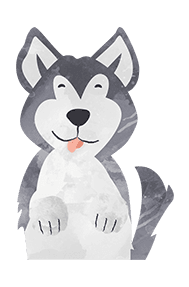Alaskan Malamute
History
The Alaskan Malamute is one of the oldest Arctic sled dog breeds, and purportedly one of the oldest dog breeds in the world whose original looks have not been significantly altered. Ivory carvings of dogs resembling today’s Malamutes have been found in settlements from around 20,000 years ago. Their impressive and wolf-like appearance has often led to Alaskan Malamutes being cast to play the role of wolves in films and TV but they are all domestic dog.
The Mahlemut Inuit tribe developed the Alaskan Malamute breed out of necessity to their way of life along the shores of Kotzebue Sound in the upper western part of Alaska. The Mahlemuts and their dogs depended on one another for survival in what is one of the harshest environments on earth. In the summer months the tribe fished and hunted inland and during the winter months they hunted whales and seals along the shore. Malamutes were used to transport the tribe’s possessions and quarry. They were taken on hunting trips to offer protection against large predators such as bears.
Malamutes are incredibly strong and hardy freight dogs capable of pulling heavy loads across the snow, surviving in extreme Arctic conditions. They also have extremely efficient metabolisms; an evolutionary necessity given food was often scarce.
They are characterised by their sunny dispositions, and love and affection for people, and in particular, a fondness for children. These traits were prized as Malamutes were also utilised as guardians, to protect the tribe’s children from predators while the parents were away hunting. Most families each had three Malamutes.
Alaskan Malamutes are notorious for being stubborn but they are in fact extremely intelligent and capable of thinking for themselves. This, again, came about because of a necessity for intelligent dogs that the tribe could depend upon for survival. For example, Malamutes will refuse to obey a musher’s commands if they sense danger, such as thin ice up ahead.
Malamutes were absolutely integral to the daily lives of the Mahlemut tribe, and the criteria for which dogs would be kept and bred was the most basic of all: survival. Those dogs best equipped to work and be of use to the tribe were the bloodlines which prevailed.
During the Gold Rush of 1896 many prospectors imported dogs of various sizes and breeds and interbred these animals with the native dogs, however, due to the relative isolation of the Mahlemut tribe, the Alaskan Malamute’s pure type remained relatively intact.
Two main strains of the breed were developed in the 1920s and 1930s by Arthur T Walden who established his Chinook Kennel, which was carried on by Milton and Eva Seeley, and became the “Kotzebue” strain, and Paul Voelker Sr who developed the “M’Loot” strain. Both strains of the breed were used in Byrd’s first and second Antarctic expeditions.
Alaskan Malamutes were first recognised as a breed by the American Kennel Club in 1935. During World War II many of the registered Alaskan Malamutes were loaned to assist in an Antarctic expedition due to the high demand for sled dogs, and tragically most were destroyed after serving their country.
The Modern Malamute
The Alaskan Malamute remains strong, independent and highly intelligent. Nowadays, they are mostly chosen for companionship but many participate in dog sports such as weight pulling, backpacking, skijoring and sledding, and even agility. Malamutes like to be involved in everything their families do, and are best suited to active, outdoorsy households that will include them in lots of activities and adventures, however, Malamutes are a slow developing breed, and pups should be kept on restricted, light exercise until the age of one, to prevent harming growing joints and bones, and serious conditions such as hip dysplasia. If you live in the UK why not join one of the many clubs or societies specifically aimed at sled dog owners, such as the AMWA (Alaskan Malamute Working Association) which is a great way to meet other owners and their dogs.
Alaskan Malamutes have retained their independent nature which has often led to them being labelled as “stubborn” or “stupid”, but with the correct upbringing and training, their intelligence is undeniable. Give a Malamute a command to do something they’re not too keen to comply with and you can practically see them thinking “What’s in it for me?” Beware: Malamutes are experts at training their owners! They thrive in environments where they are treated with love and respect, and are part of the team. It is important for Malamutes to be provided with plenty of opportunities to exercise, and kept mentally stimulated. Bored or restless Alaskan Malamutes can easily become unhappy and destructive.
Many owners claim their Malamutes have a cheeky sense of humour! Alaskan Malamutes make terrible guard dogs as they see everyone, including complete strangers and first time visitors, as their friends. An Alaskan Malamute is more likely to roll over for belly rubs than to protect your home from any would-be intruders. It is completely out of character for an Alaskan Malamute to show aggression towards a human; should your dog exhibit this type of behaviour you must seek professional help immediately.
Alaskan Malamutes are pack dogs and are obsessed with pack hierarchy. Same sex aggression is common in the breed. Early and intense canine socialisation of your puppy is strongly recommended to ensure that as an adult your Malamute behaves appropriately when meeting and interacting with other dogs. Just as with humans, Malamutes go through an adolescence phase and many effectively become stroppy teenagers, pushing the boundaries and testing their owners to see exactly what they can get away with. This is a testing time but persevere with your teenage furry by remaining calm, firm and consistent at all times, always praising and reinforcing good behaviour, and you will eventually be rewarded by seeing your pup mature into a companion that is a pleasure to share your life with.
The modern Malamute has also retained a strong prey drive instinct, and whilst each dog is different, most Malamutes cannot be trusted around small furries unless raised together, but even then caution should always be exercised. A Malamute raised in a home with cats may grow to accept the family cats as part of their pack but this does not mean that they will not chase and kill an unfamiliar cat visiting your garden. Due to their high prey drives, Malamutes should never be allowed off lead in areas near livestock, and a farmer is within their rights to shoot on sight any dog worrying animals on their land.
In general terms, Alaskan Malamutes have poor recall and should not be trusted off lead unless in safe and secure areas. Even Malamutes who have demonstrated excellent recall for years can be overcome by instincts very deeply ingrained in their DNA and suddenly become so focused on something that nothing at all can distract them, and they will not return to their owners on command. Sadly, this is an all too common scenario that often has tragic consequences. It is up to every owner to be aware of the risks they take when allowing their dogs off lead in any given situation. No matter whether you intend to allow your dog off lead or not, recall training is strongly recommended in the event of an accident occurring such as a lead snapping or your dog escaping from your home or garden.
Appearance and vocalizations
Their thick double coat consists of a soft downy insulating undercoat and an outer coat of coarse guard hairs which are almost oily to the touch which help repel snow and water, much like a duck’s feathers. In blizzard conditions, Malamutes will curl up tucking their noses under their tails. Their dense fur is so efficient at insulating their body heat that snow does not melt upon contact with their coats.
They are powerfully built animals with a wide chest to help them barrel through deep snow and because this is also the area from which they get their strength to pull. Their weight is spread across their large snowshoe paws to prevent them punching through the snow, or if necessary, they can actually paddle through the snow, much like swimming. They even have retractable claws similar to a cat, to help them gain traction on the ice.
There are some slight differences in the UK and American Kennel Club breed standards.
UK Kennel Club breed standard for Alaskan Malamutes: http://www.thekennelclub.org.uk/services/public/breed/standard.aspx?id=5105
American Kennel Club breed standard for Alaskan Malamutes: https://www.akc.org/breeds/alaskan_malamute/breed_standard.cfm
The Alaskan Malamute is a beautiful breed but that gorgeous coat does not just stick to your dog. If you are very house-proud DO NOT GET A MALAMUTE. Most Malamutes do not require much more than a quick daily brush except for when they are blowing their coat (unless you own a woolly coated Malamute in which case be prepared to put in a lot of work every day into that keeping that coat looking glorious). During this period, which can continue for weeks if not months at a time, Malamute owners have to contend with extremely heavy shedding. Be prepared to find fur EVERYWHERE! Invest in a rake and slicker brush to remove the loose fur, and a good quality vacuum cleaner (plus plenty of lint rollers to offer your guests). Malamutes have remarkably effective self-cleaning coats and should not be bathed except when necessary, to prevent stripping of the coat and skin’s natural oils.
The Alaskan Malamute is generally considered to be a quiet dog in actual fact this rarely seems to be the case with most Malamutes displaying a rich and complex vocabulary, ranging from deep grumbling to woo woos, yips, chirps and much more. Malamutes can actually be extremely talkative and if you engage a chatty Malamute in conversation they will “talk” away as if they are replying to you and may even tell you a long story (or so it seems). There are even some Malamutes who always seem to want to get the last word in! George Lucas’s Malamute, Indy, was the inspiration behind the vocals of the Star Wars Wookie character, Chewbacca. Malamutes howl, and many will answer (at maximum volume) the call of passing sirens on ambulances, police vehicles and fire engine trucks, or even ice cream vans.
Alaskan Malamutes are not for everyone, and they sure can be hard work; invite one into your life and it will never be the same again! Sharing your life with a Malamute is an amazing journey – treasure every moment.
[hr]
I am an Alaskan Malamute – by Bob Riddle
I am an Alaskan Malalmute. The secret of where I first came from is hidden deep in the blizzard snows of the polar ice, and there is where it will stay. Modern man has no idea where I came from, and the ancient Mahlemut Indians that worked to develop my breed will not reveal the secret. I will tell you that I am a breed that loves man beyond even my own understanding. I am one that has a sense of humour, I find joy in work that causes other breeds to cringe. Some humans think that I am stubborn, and therefore not very smart, but I am one of the most intelligent dogs in the world. I have often used my brain and humour to frustrate my human friends, but if you take the time to understand me and my independence,you will find out how smart I really am. If I sound as if I am bragging, I’m not. I do not believe in false modesty, nor any other falsehoods. I do not know how to lie. You will see in my eyes the kind of honesty that men can only hope to find. Through my bloodlines God blessed me with a body that contains power that other breeds envy. Of the northern breeds, I have no peer. My fur is such that the most frigid winter blast is to me but a refreshing breeze. While my size and appearance can intimidate some people, most are drawn to my looks.If you help me understand what you want (by working with me a lot), and you treat me with love and respect, I will usually do as you ask of me. I have courage that any Marine would be proud to claim. If forced into a fight, I am ferocious; in competition I do not like to lose. If a human chooses to become my companion, and treats me with love and kindness I will sacrifice my very life to keep that human from harm.
When you fully comprehend the Aurora Borealis; then will you understand me………..I am Alaskan Malamute.




